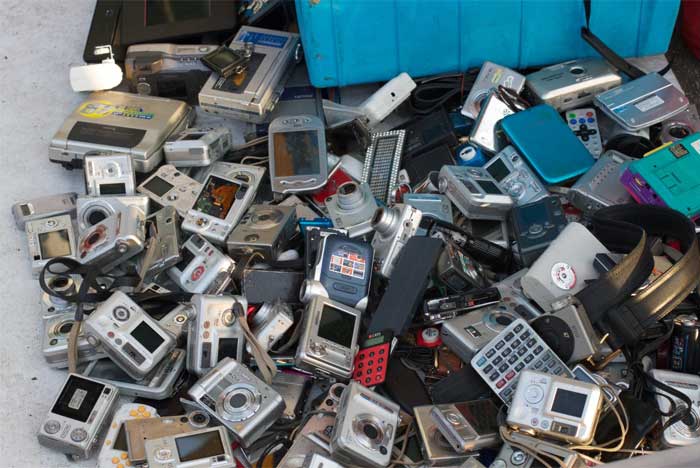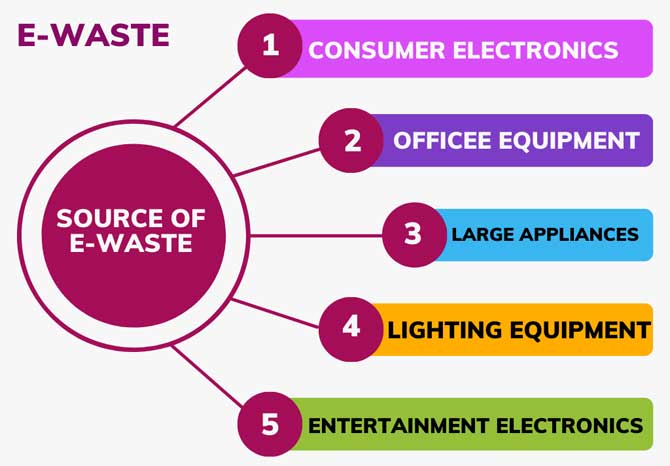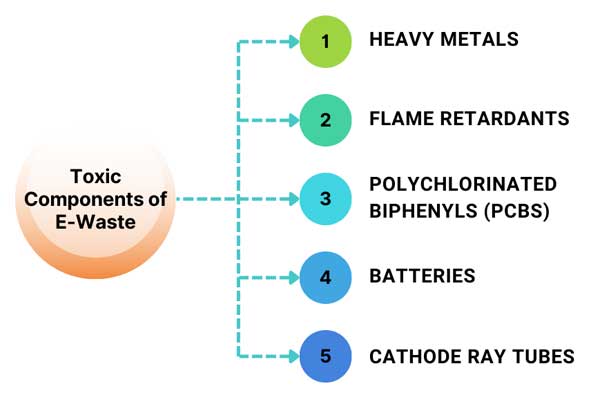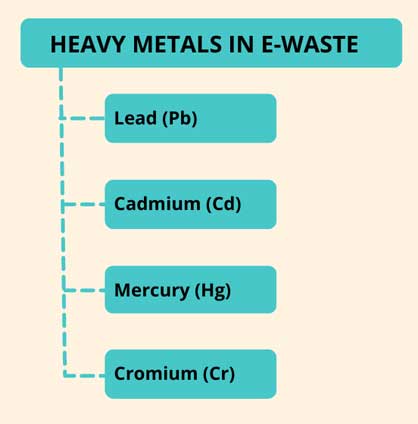What is E-waste?
E-waste is electronic waste. It refers to discarded electronic devices or equipment such as computers, mobile phones, televisions, digital cameras, and other electronic appliances. The present article discusses the ecological problems, effects of e waste on human body and strategies for the management of e-waste for a better environment.
Ø E-waste can pose environmental and health hazards if not properly disposed of.
Ø Electronic devices often contain toxic materials, such as lead, mercury, and cadmium.
Ø They can contaminate soil and water sources and can reach trophic levels.
Ø E-waste can also release hazardous gases into the atmosphere, contributing to air pollution and climate change.

Main Source of E-Waste
(1). Consumer electronics: Includes items like mobile phones, computers, laptops, as well as smaller electronics like digital cameras, headphones, and gaming devices.
| You may also like NOTES in... | ||
|---|---|---|
| BOTANY | BIOCHEMISTRY | MOL. BIOLOGY |
| ZOOLOGY | MICROBIOLOGY | BIOSTATISTICS |
| ECOLOGY | IMMUNOLOGY | BIOTECHNOLOGY |
| GENETICS | EMBRYOLOGY | PHYSIOLOGY |
| EVOLUTION | BIOPHYSICS | BIOINFORMATICS |
(2). Office equipment: Include printers, scanners, copiers, and other electronic devices used in workplaces.
(3). Large appliances: Items like refrigerators, air conditioners, washing machines, and dryers can all produce e-waste when they are disposed of.
(4). Lighting equipment: Includes fluorescent bulbs, LED bulbs, and other lighting devices.

(5). Medical devices: Some medical devices, such as X-ray machines, can produce e-waste when they are no longer in use.
(6), Electrical equipment: This includes items like power tools, extension cords, and other equipment that uses electricity.
(7). Entertainment electronics: This can include items like televisions, stereos, DVD players, and other devices used for entertainment purposes.
Environmentally Toxic Components Present in E-Waste
E-waste contains several environmentally toxic components that can pose a risk to human health and the environment
(1). Heavy metals: Heavy metals like lead, mercury and cadmium will be present in e-wastes. These metals can be harmful to humans and animals, and can contaminate soil and water sources if not disposed properly.
(2). Flame retardants: Many electronic devices contain flame retardants that are designed to prevent fires. These chemicals can be harmful to human health and contribute to environmental pollution.
(3). PCBs: Polychlorinated biphenyls (PCBs) are a type of organic compound that were used in electrical equipment like transformers and capacitors. PCBs are highly toxic and can persist in the environment for many years.
(4). Batteries: Batteries of electronic devices can contain toxic chemicals like lithium, cadmium, and nickel. These chemicals can be harmful to human health and can also contaminate the environment if not disposed of properly.
(5). Cathode ray tubes: CRTs are used in older televisions and computer monitors. These tubes contain lead, which can be harmful to human health and the environment.

Heavy Metals Present in E-Wastes
E-waste can contain a variety of heavy metals, which can be harmful to human health and the environment. Some of the heavy metals commonly found in e-waste are:
(1). Lead (Pb): This is one of the most toxic heavy metals present in e-waste. Lead can cause neurological and developmental problems, especially in children.
(2). Mercury (Hg): This is a highly toxic heavy metal that can cause a range of health problems, including damage to the nervous system, kidneys, and brain.
(3). Cadmium (Cd): This heavy metal can cause lung and prostate cancer, kidney damage, and other health problems.
(4). Chromium (Cr): This metal can cause lung cancer, and is also a potent skin irritant.
(5) Arsenic (As): Arsenic is a carcinogen and can cause skin, lung, and bladder cancer.

The heavy metals in the e-wastes can leach into the soil and groundwater, leading to contamination of the local environment and potentially causing health problems for people and wildlife. They can also accumulate in different trophic levels of the ecosystem and can cause biomagnification.
Hazardous Effects of E-waste on the Environment
E-waste can have several hazardous effects on the environment, including:
(1). Soil and water contamination: The toxic materials in e-waste like lead, mercury, and cadmium can leach into the soil and contaminate water sources. This can be harmful to humans and animals that met contaminated soil or water.
(2). Air pollution: When e-waste is burned, it can release toxic chemicals into the air, contributing to air pollution. This can have negative effects on human health and can contribute to climate change.
(3). Harm to wildlife: Animals can be harmed by e-waste when they ingest or meet toxic materials.
(4). Electronic waste dumping: Improper disposal of e-waste can lead to illegal dumping, which can pollute the environment and create health hazards for people who live in or near the dumping sites.
(5). Resource depletion: E-waste contains valuable resources like gold, silver, and copper that can be reused in new products. When e-waste is not recycled or properly disposed of, these resources are wasted and the need for mining and manufacturing new materials increases, which can have additional environmental impacts.
Measures to Reduce the E-Waste
(1). Buy durable and long-lasting products
Ø One of the most effective ways to reduce e-waste
Ø Try to buy electronic devices that are designed to last for several years.
(2). Donate or sell old electronics
Ø Instead of throwing away old electronics, consider donating or selling them to someone who could use them.
Ø This can help to extend the life of the product and prevent it from becoming e-waste.
(3). Recycle electronics
Ø When electronics can no longer be used or repaired, it is important to recycle them properly.
Ø Many retailers and manufacturers offer recycling programs for electronic devices.
(4). Repair electronics
Ø Repairing electronic devices instead of replacing them can help to extend their lifespan and reduce e-waste.
(5). Use eco-friendly products
Ø When purchasing new electronic devices, look for eco-friendly options.
Ø This can include products that are made with sustainable materials, use less energy, or have a lower environmental impact.

(6). Reduce consumption
Ø The most effective way to reduce e-waste is to simply consume less
Ø This can involve using electronic devices for longer periods, sharing devices with others, or choosing to use products that have a lower environmental impact.
By taking these measures, individuals and organizations can help to reduce e-waste and minimize its impact on the environment.
Legal Approaches to Reduce E-waste
Ø To combat the negative effects of e-waste, many countries have implemented regulations or guidelines for the disposal of electronic devices.
Ø This may include requirements for manufacturers to provide recycling or disposal services for their products, or for consumers to dispose of electronic devices at designated collection points.
| You may also like... | ||
|---|---|---|
| NOTES | QUESTION BANK | COMPETITIVE EXAMS. |
| PPTs | UNIVERSITY EXAMS | DIFFERENCE BETWEEN.. |
| MCQs | PLUS ONE BIOLOGY | NEWS & JOBS |
| MOCK TESTS | PLUS TWO BIOLOGY | PRACTICAL |
Ø Some countries also prohibit the export of electronic waste to developing countries, where it is often improperly disposed of or processed under unsafe conditions.
The proper disposal and recycling of electronic waste can help to reduce the environmental impact of discarded electronic devices. Many electronic components, such as metals, plastics, and glass, can be recovered and reused through recycling or other forms of responsible disposal. Some electronics manufacturers have also developed programs to repurpose or refurbish old devices, extending their lifespan and reducing the amount of electronic waste generated.
<<< Back to ECOLOGY Notes Page
Dear readers
I believe that this article helped you to understand the E-waste and its Harmful Effects. I would like to take this opportunity to request your feedback and COMMENTS on the topics I have covered. Whether you have a suggestion, a question about the topic, or simply want to share your thoughts, I would love to hear from you. Your comments provide me with the opportunity to engage in meaningful discussion and continue to write with the best possible content in Biology.
So, please do not hesitate to leave a comment below. I appreciate your support and look forward to hearing from you.
Best regards, [Admin, EasyBiologyClass]
